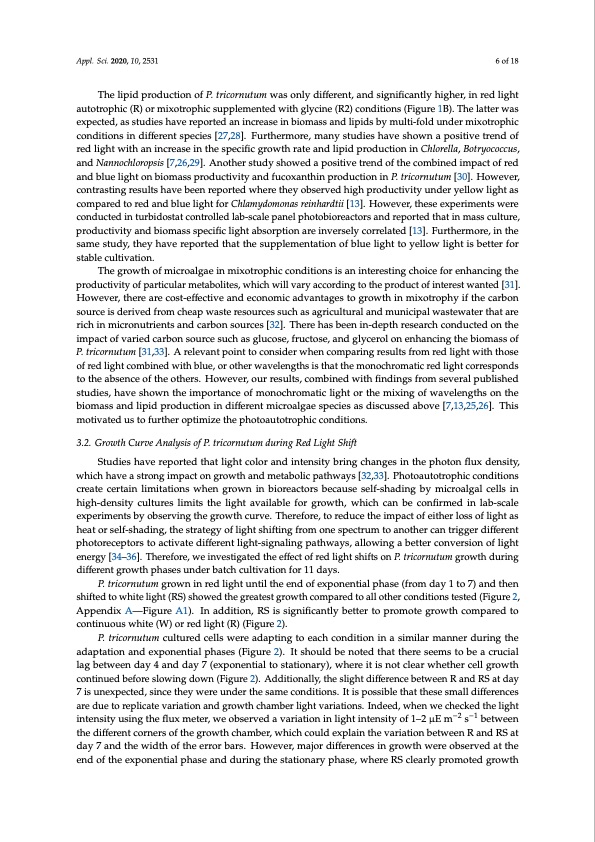
PDF Publication Title:
Text from PDF Page: 006
Appl. Sci. 2020, 10, 2531 6 of 18 The lipid production of P. tricornutum was only different, and significantly higher, in red light autotrophic (R) or mixotrophic supplemented with glycine (R2) conditions (Figure 1B). The latter was expected, as studies have reported an increase in biomass and lipids by multi-fold under mixotrophic conditions in different species [27,28]. Furthermore, many studies have shown a positive trend of red light with an increase in the specific growth rate and lipid production in Chlorella, Botryococcus, and Nannochloropsis [7,26,29]. Another study showed a positive trend of the combined impact of red and blue light on biomass productivity and fucoxanthin production in P. tricornutum [30]. However, contrasting results have been reported where they observed high productivity under yellow light as compared to red and blue light for Chlamydomonas reinhardtii [13]. However, these experiments were conducted in turbidostat controlled lab-scale panel photobioreactors and reported that in mass culture, productivity and biomass specific light absorption are inversely correlated [13]. Furthermore, in the same study, they have reported that the supplementation of blue light to yellow light is better for stable cultivation. The growth of microalgae in mixotrophic conditions is an interesting choice for enhancing the productivity of particular metabolites, which will vary according to the product of interest wanted [31]. However, there are cost-effective and economic advantages to growth in mixotrophy if the carbon source is derived from cheap waste resources such as agricultural and municipal wastewater that are rich in micronutrients and carbon sources [32]. There has been in-depth research conducted on the impact of varied carbon source such as glucose, fructose, and glycerol on enhancing the biomass of P. tricornutum [31,33]. A relevant point to consider when comparing results from red light with those of red light combined with blue, or other wavelengths is that the monochromatic red light corresponds to the absence of the others. However, our results, combined with findings from several published studies, have shown the importance of monochromatic light or the mixing of wavelengths on the biomass and lipid production in different microalgae species as discussed above [7,13,25,26]. This motivated us to further optimize the photoautotrophic conditions. 3.2. Growth Curve Analysis of P. tricornutum during Red Light Shift Studies have reported that light color and intensity bring changes in the photon flux density, which have a strong impact on growth and metabolic pathways [32,33]. Photoautotrophic conditions create certain limitations when grown in bioreactors because self-shading by microalgal cells in high-density cultures limits the light available for growth, which can be confirmed in lab-scale experiments by observing the growth curve. Therefore, to reduce the impact of either loss of light as heat or self-shading, the strategy of light shifting from one spectrum to another can trigger different photoreceptors to activate different light-signaling pathways, allowing a better conversion of light energy [34–36]. Therefore, we investigated the effect of red light shifts on P. tricornutum growth during different growth phases under batch cultivation for 11 days. P. tricornutum grown in red light until the end of exponential phase (from day 1 to 7) and then shifted to white light (RS) showed the greatest growth compared to all other conditions tested (Figure 2, Appendix A—Figure A1). In addition, RS is significantly better to promote growth compared to continuous white (W) or red light (R) (Figure 2). P. tricornutum cultured cells were adapting to each condition in a similar manner during the adaptation and exponential phases (Figure 2). It should be noted that there seems to be a crucial lag between day 4 and day 7 (exponential to stationary), where it is not clear whether cell growth continued before slowing down (Figure 2). Additionally, the slight difference between R and RS at day 7 is unexpected, since they were under the same conditions. It is possible that these small differences are due to replicate variation and growth chamber light variations. Indeed, when we checked the light intensity using the flux meter, we observed a variation in light intensity of 1–2 μE m−2 s−1 between the different corners of the growth chamber, which could explain the variation between R and RS at day 7 and the width of the error bars. However, major differences in growth were observed at the end of the exponential phase and during the stationary phase, where RS clearly promoted growthPDF Image | Red Light Variation Lipid Profiles in Phaeodactylum tricornutum

PDF Search Title:
Red Light Variation Lipid Profiles in Phaeodactylum tricornutumOriginal File Name Searched:
applsci-10-02531.pdfDIY PDF Search: Google It | Yahoo | Bing
Cruise Ship Reviews | Luxury Resort | Jet | Yacht | and Travel Tech More Info
Cruising Review Topics and Articles More Info
Software based on Filemaker for the travel industry More Info
The Burgenstock Resort: Reviews on CruisingReview website... More Info
Resort Reviews: World Class resorts... More Info
The Riffelalp Resort: Reviews on CruisingReview website... More Info
| CONTACT TEL: 608-238-6001 Email: greg@cruisingreview.com | RSS | AMP |